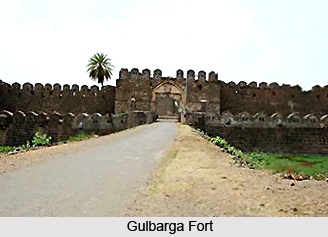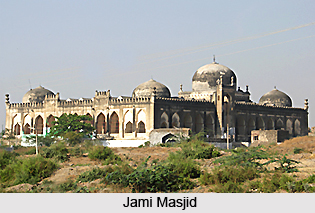 The monuments of Gulbarga reflect a rich historical past. From being a Hindu city to later becoming the capital of a Muslim Empire, Gulbarg has an enriching share of cultural legacy. Dynasties proclaiming allegiance to either religion have held fort here at one time or another, though the majority of architectural construction is attributed to the Muslim dynasty of the Bahmanis.
The monuments of Gulbarga reflect a rich historical past. From being a Hindu city to later becoming the capital of a Muslim Empire, Gulbarg has an enriching share of cultural legacy. Dynasties proclaiming allegiance to either religion have held fort here at one time or another, though the majority of architectural construction is attributed to the Muslim dynasty of the Bahmanis.
Gulbarga is situated 353 miles from Bengaluru and is a rapidly growing town of major historical importance. The city lies on an undulating plain of rich black soil. The major Hindu dynasties that ruled Gulbarga were the Chalukyas of Badami and the Hoysalas of Dwarasamudra. The first Muslim Kingdom emerged in 1347 with the establishment of the Bahmani Sultanate. The dynasty was founded by Hasan Gangu who took the name of Bahman and made Gulmarg his capital. The Bahmani dynasty ruled the affairs of the Deccan for almost two hundred years before the kingdom disintegrated into five fragments- Ahmadnagar, Berar, Bidar, Bijapur and Golconda. It went through a succession of rulers till it was finally taken over by the rulers of the Mughal dynasty.
Historical Monuments of Gulbarga
There are a number of monuments found in Gulbarga exhibiting some of the earliest examples of Islamic architecture in Karnataka.
To the north-west of the region lies the fort. It was originally built by Raja Gulchand and later strengthened by Ala-ud-Din Hasan Bahman Shah. The fort is a magnificent structure with fifteen towers and twenty-six guns. The entrance is approached by a ruined flight of steps high up on the North wall. Though the outer walls are in a bad state, the main Bala Has or the citadel is well preserved. It lies right in the centre of the fort complete with semi-circular turrets on the sides and corners. Contained in it is a huge canon, 7-9 m long, with twenty pairs of iron rings attached to it.
The entrances to the fort lie in the middle of the east and west walls respectively. The outer barbican of the east gateway has disappeared and the old drawbridge has been replaced by a motor road over the moat. The west gate is a massive structure, once protected by outworks. These project out as a hornwork beyond the fort and comprise four successive courts and doors. The outer door, with its twisted spikes, is still intact.
Religious Monuments of Gulbarga
Located within the Fort, to the North West of the citadel is the Jami Masjid.built in 1367, it resembles the Great Mosque at Cordoba in its form and dimensions. A description at the gate near the entrance credits the construction of the mosque to Rafi, son of Shams, the son of Mansur of Qazvin.However the scale design and ornamentation suggest that it might have been constructed during the reign of Firuz Shah, in the early 15th century. It measures 216 ft by 176 ft and is unique in India, as the whole area is covered by a large dome over the mihrab, by four corner domes and by seventy-five smaller ones. Great arches pierce the flanks on three sides.
 To the North of Gulbarga lies the Langar ka Masjid. It is a fine mosque and tomb dating back to the fifteenth century. The mosque displays excellent stucco ornament. It has an unusual pointed, ribbed vault over the prayer chamber.
To the North of Gulbarga lies the Langar ka Masjid. It is a fine mosque and tomb dating back to the fifteenth century. The mosque displays excellent stucco ornament. It has an unusual pointed, ribbed vault over the prayer chamber.
There are two groups of Royal tombs found in the city. One group lies to the West of the fort and the other lies to the East of the city. The tombs found herein are of two types- single tombs, which consist of simple square chambers with crenellations and corner turrets covered by a single dome, and, double tombs which are grander developments of the same tradition. All the tombs are a hundred feet high and robustly built though roughly finished. Some of them do exhibit some fine tracery.
The tombs west of the fort stand in the fields a short distance beyond the west gate of the citadel. Those of Ala-ud-Pin Hasan Bahman Shah built in 1358 and Muhammad I (1375) and Muhammad II (1397) arc-typical of the series, with square domed chambers, sloping walls, low flattish domes and corner finials derived from Tughluq models.
To the East of the city are the tombs of several Sultans in a complex known as the Haft Guru. The tombs of Ala-ud-Din Mujahid and Dawud I are similar to earlier Bahmani tombs, although the latter has two domed chambers linked to form a double mausoleum.
The masterpiece of the series is the tomb of Taj-ud-Din Firuz. Monumentally conceived and elaborately ornamented, it is a thoroughly developed composition with geometric patterns in pierced masonry, bands of lotus decoration and arabesques and temple-like brackets supporting the angled eaves.
Apart from the mosques and tombs, a number of Dargahs are also found in Gulbarga.
A revered site at Gulbarga is the Dargah of Hazrat Gesu Nawaz, a saint of the Chisti order who came to Gulbarga in 1413.Venerated by both Hindus and Muslims alike, it is a large complex of tombs, mosques, madrasas, courtyards and gateways which conveys the influence of this Chishti saint on the history of south India. Architectural styles spanning two centuries are seen in the buildings here. The tomb has two stories divided into arched recesses, with an enriched parapet and a frieze of indented squares. A later addition was made in the form of a Mother of pearl canopy over the grave.
In the south court is a small mosque built in the style of the Adil Shahi period, erected by Afzal Khan. The huge arch flanked by two high towers is 17th century. Heraldic animals carried on fish-like brackets are depicted on the stucco medallions.
To the South-East of this complex is the Dargah of Shah Kamal Mujarrad, another saint who lived at Gulbarga. The Dargah comprises a small, unadorned tomb in late-14th-century style, a mosque and two other structures. On the mosque is engraved the most elaborate stucco ornament to be found in Gulbarga, with multi-lobed bands of enriched plaster and roundels. The other buildings were probably sarais or rest-houses.
Dargah of Shaikh Suraj-ud-Din Junaydi lies to the North-West of the fort close to the tombs of the earliest rulers. It is the spiritual preceptor of the first Bahmani sultans. There is a simple tomb in fourteenth-century style and a small plain mosque. The most interesting feature of the Dargah is the monumental gateway added by Yusuf Adil Khan, the founder of the Bijapur kingdom. It is framed by two tall minarets and has a long, arcaded frontage.
To the west of the city is the Chor Gumbad, a tomb built in 1420 with a high dome, plain facades and miniature corner towers.
Gulbarga is a melting pot of different traditions. It continues to remain a city of great historical significance due to the prevalence of so many monumental works of art contained within it.



















